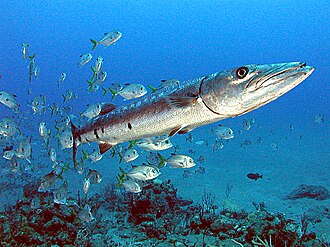- Barracudas are predatory fish found in warm, tropical waters around the world.
- They have a streamlined body shape with a long, torpedo-like appearance, enabling them to swim swiftly through the water.
- Barracudas are known for their sharp teeth and powerful jaws, which they use to catch and devour their prey.
- They are carnivorous fish and primarily feed on smaller fish, but they can also eat crustaceans and squid.
- Barracudas have an aggressive hunting style, often using surprise attacks and their speed to catch their prey.
- They are known for their incredible swimming speed and agility, capable of reaching speeds up to 35 miles per hour (56 km/h).
- Barracudas have a fearsome reputation among divers due to their occasional display of aggression and curiosity towards shiny objects, such as diving equipment.
- They have a diverse range of sizes, with some species reaching lengths of up to 6 feet (1.8 meters) or more.
- Barracudas have excellent eyesight and can detect movement and prey from a considerable distance.
- They are found in both coastal and offshore habitats, including coral reefs, mangroves, and open ocean areas.
- Barracudas are known for their voracious appetite, often consuming prey that is half their own size or even larger.
- They have a lateral line system along their bodies, which allows them to detect vibrations and changes in water pressure, helping them locate prey.
- Barracudas are not typically a threat to humans, but in rare instances, they may exhibit aggressive behavior if they feel threatened or cornered.
- They have sharp, pointed scales known as “scutes” that provide protection against predators and reduce drag while swimming.
- Barracudas have a lifespan of around 10 to 15 years in the wild, depending on the species.
- They are highly migratory and can cover long distances in search of food and suitable habitats.
- Barracudas have a complex social structure and are often found in small groups or schools, particularly during spawning periods.
- They are capable jumpers and have been observed leaping out of the water to catch prey or evade predators.
- Barracudas have a unique ability to change their coloration and patterns, allowing them to blend into their surroundings and ambush unsuspecting prey.
- They are popular targets for sport fishing due to their fighting ability and reputation as fierce predators.
- Barracudas have been studied for their ability to detect and navigate using Earth’s magnetic fields, similar to other migratory species.
- They have a specialized swim bladder that helps control their buoyancy, allowing them to remain at specific depths in the water column.
- Barracudas have a keen sense of smell, which helps them locate prey even in murky waters.
- They have a rapid growth rate, reaching sexual maturity within a few years.
- Barracudas are known for their powerful bite, capable of inflicting serious injury with their sharp teeth.
- They have a preference for warm waters and are more commonly found in tropical and subtropical regions.
- Barracudas have been observed engaging in feeding frenzies, where multiple individuals converge on a school of fish, creating a spectacle of thrashing and splashing in the water.
- They have a reflective layer behind their retina called the “tapetum lucidum,” which enhances their vision in low-light conditions.
- Barracudas are sometimes targeted by parasites, such as copepods and isopods, which attach themselves to the fish’s gills and skin.
- They have a high tolerance for salinity variations and can be found in both freshwater and saltwater environments.
- Barracudas have been featured in various cultural references, including literature, films, and art, often portraying them as fierce and formidable creatures.
- They have sharp, curved teeth arranged in multiple rows, allowing them to replace damaged or lost teeth quickly.
- Barracudas have a unique mechanism in their jaws that enables them to extend their upper jaw forward to capture prey efficiently.
- They are important predators in their ecosystems, helping to regulate fish populations and maintain a balance in marine food webs.
- Barracudas have a reputation for stealing catches from fishing lines, often snatching fish right off the hooks.
- They have a streamlined body shape and a large caudal (tail) fin, which provides them with exceptional swimming speed and maneuverability.
- Barracudas have been known to engage in cooperative hunting, where multiple individuals work together to encircle and trap a school of fish.
- They have a keen sense of hearing, detecting low-frequency sounds and vibrations in the water.
- Barracudas have been observed using their sharp teeth to scrape off scales from larger fish before consuming them.
- They are highly adaptable and can adjust their feeding habits based on the availability of prey in their environment.
- Barracudas have been known to migrate long distances to spawning grounds, where they release their eggs and sperm into the water column.
- They are known to be cannibalistic, with larger individuals occasionally preying on smaller barracudas.
- Barracudas have a distinct hunting strategy, often stalking their prey before launching a swift and powerful attack.
- They have a complex set of muscles along their body, allowing for quick acceleration and sudden changes in direction.
- Barracudas are capable of detecting minute electrical impulses emitted by their prey, helping them locate hidden or camouflaged prey items.
- They have a high metabolic rate and require a substantial amount of food to sustain their energy needs.
- Barracudas have a keen sense of spatial awareness, allowing them to navigate through complex reef structures with precision.
- They have been known to form symbiotic relationships with other fish species, providing protection to smaller fish in exchange for cleaning services.
- Barracudas have a remarkable ability to regenerate damaged or lost scales, ensuring their bodies remain protected.
- They are fascinating creatures that continue to intrigue scientists and divers with their predatory behavior and remarkable adaptations.
Facebook Comments


































